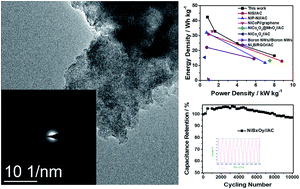Facile and scalable production of amorphous nickel borate for high performance hybrid supercapacitors†
Abstract
Much research attention has been paid to transition metal borates, especially nickel borate, for their potential application in energy conversion and storage. Herein, for the first time, amorphous nickel borate has been synthesized via a facile and scalable co-precipitation method at room temperature and hybrid supercapacitors have been fabricated based on the synthesized amorphous nickel borate. A high specific capacity of 137.9 mA h g−1 can be achieved in three-electrode configurations. The assembled asymmetric hybrid supercapacitor device with active carbon as the counter electrode shows a high energy density of 42.4 W h kg−1 at a power density of 800 W kg−1. Even after 10 000 charge–discharge cycles, cycling at a high current density of 10 A g−1, the device still retained over 97% specific capacity. These outstanding electrochemical performances can be attributed to the large surface area and abundant inherent defects that allow full contact between the electrode materials and electrolyte. These findings pave the way for exploring other transition metal borates and amorphous materials for high performance supercapacitor electrodes.



 Please wait while we load your content...
Please wait while we load your content...